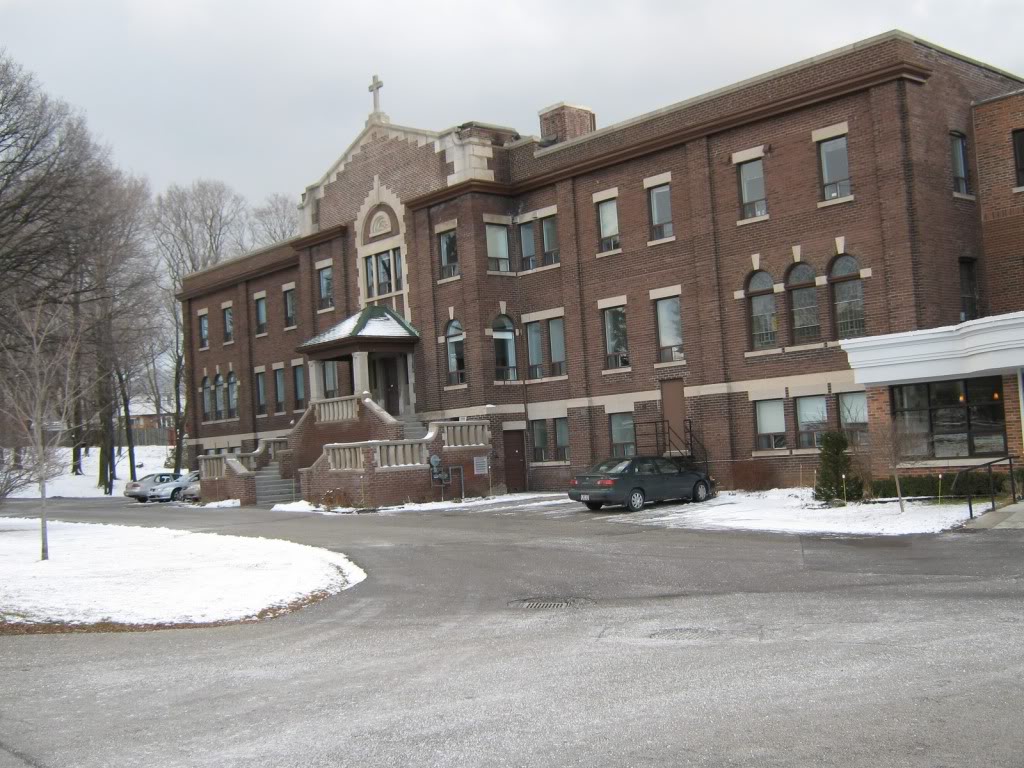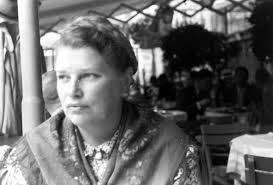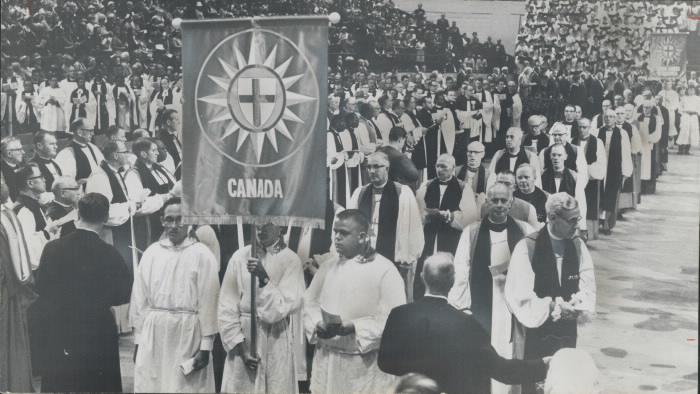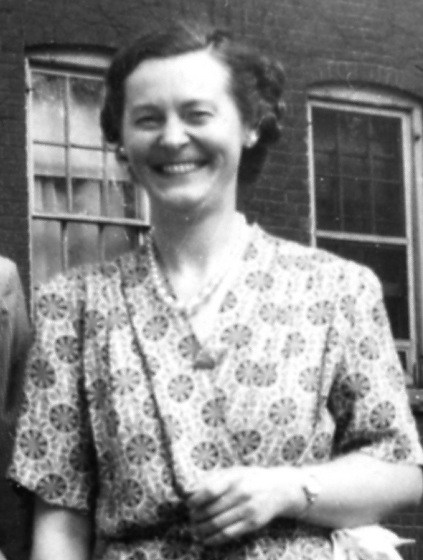Church missions
WYH3271HS Winter 2017 February 9, 2017
Links
"Relations Between the Catholic Church and CCF in Saskatchewan, 1930-1950", by Sister Teresita Kambeitz.
"The Catholic Church and the CCF," by Murray G. Ballantyne.
Canadian missions before and after 1960
In the late 1950s and early 1960s, mission theory and practice changed.
- The clearest change was that the churches began to close Indian residential schools, and increasingly recognized that they had been horribly misconceived. (This dimension of things is discussed on another webpage.)
- The goal of the "evangelization of the world in this generation," a missionary slogan of the early 20th century, was no longer an aspiration.
- Missiologists were recognizing that a great deal of the missionary enterprise had been tainted with cultural imperialism, and other kinds of imperialism too.
- The mainline Protestant churches reconceived foreign missions as partnerships. But Protestant evangelical missions blossomed.
- Roman Catholics reframed missions in the light of Vatican II.
- Ecumenical social justice initiatives blossomed for a while, and some still continue.
Roman Catholic missions in Canada
Scarboro Foreign Mission Society
 This remains the only English Canadian Catholic mission society.
This remains the only English Canadian Catholic mission society.
- Its predecessor organization, the China Mission College, was founded in 1918 in Almonte, Ontario, by John Mary Fraser, who had been the first English Catholic priest from Canada to work in China. It changed its name and moved to Scarborough, Ontario, and then received its present name in 1940.
- It concentrated on China until the Japanese invasion in World War II, and then the Communist Revolution. Then it opened mission fields in the Caribbean, the Philippines, Japan, and elsewhere.
- A good discussion of how it was changed by Vatican II is Erin F. Phllips, "The Impact of the Second Vatican Council on the Scarboro Foreign Mission Society (1959-1968)," Canadian Catholic Historical Association Historical Studies 52 (1985): 97-112.
- He notes that before Vatican II missionaries were instructed that their first priority was personal sanctification, since that was the basis of their apostolate. Their mission work included running schools, exercising a pastoral ministry, seeking converts (usually from other religions, or, in the case of the Bahamas, from Protestantism), planting chapels, and feeding the poor.
- After Vatican II, the Society began to elevate the strategy of cultural adaptation, aspired to involvement in the whole life of a community, sided with the poor against governments, championed Vatican II church reforms, and adopted more collegial forms of decision making.
Catholic social action and the CCF
Pope Pius XI proclaimed the encyclical Quadragesimo Anno in 1931. It was subtitled "reconstructing the social order". It condemned both unrestrained capitalism and totalitarian socialism. It affirmed private property, as long as it serves the common good. It hoped that owners of industry, workers, and government would work together harmoniously. It also established the value of 'subsidiarity': decisions should be taken at the lowest, smallest, or most decentralized possible level of authority.
Perhaps oddly, it was used to justify both fascism (as by Benito Mussolini in Italy) and liberal reform and social welfare models (as by Franklin D. Roosevelt in the United States).
Its condemnation of socialism was often used by the magisterium in Canada to oppose the Cooperative Commonwealth Federation (CCF), a socialist political party founded in 1932 in Calgary. The CCF had strong social gospel and United Church connections. In some places, notably British Columbia, it was notably anti-Catholic. Archbishop Gauthier of Montreal condemned the CCF by name in 1934. Roman Catholic socialists argued that the the Pope's condemnation of socialism was aimed at totalitarian socialism, not democratic socialism. They weren't always succesful in their arguments. Fr. Eugene Cullinane, a high-profile Catholic social thinker, joined the CCF in 1945 and was forced by his bishop to resign in 1948; his story is told by Bernard Daly, "A Priest's Tale: The Evolution of the Thinking of Eugene Cullinane, CSB." But many lay Catholics did support the CCF.
As the CCF moderated its positions and tone (becoming the New Democratic Party in 1961), it became increasingly acceptable to the Roman Catholic Church. The only two Roman Catholic priests to serve as Members of Parliament in the House of Commons, Andy Hogan and Bob Ogle, were NDP'ers.
The Antigonish Movement
The Antigonish Movement was developed in 1928 under Fr. Moses Coady. It was led from St. Francis Xavier University in Nova Scotia, and since 1959 its work has been continued there by the Coady International Institute. Coady He sponsored mass meetings and study groups and leadership schools that fueled a cooperative movement (for farmers and fisheroflk) and credit unions. The impact of the movement was felt across the Maritimes and beyond.
Madonna House
 Catherine de Hueck (1896–1985), later Catherine Doherty, a Russian immigrant to Canada, was a progressive lay Catholic activist for social justice. Her cause for canonization is currently before the Vatican. She began a Friendship House in Toronto in 1934, which provided food, shelter, clothing , and social activities to the poor and unemployed. Moving to Combermere, Ontario, with her husband in 1947, she began Madonna House as an activist community with a rural apostolate and a training centre. Her community began welcoming priests, and with the inspiration of Pope Pius XII, it became a community of priests and committed celibate laymen and women practicing voluntary poverty. After Vatican II it developed an identity as a lay ecclesial community with the church status of a `public association of Christian faithful`. It adopted the progressive social agenda of Vatican II, promoted the leadersihp of women, and embraced the Liturgical Movement. Today it administers 23 field houses in six countries.
Catherine de Hueck (1896–1985), later Catherine Doherty, a Russian immigrant to Canada, was a progressive lay Catholic activist for social justice. Her cause for canonization is currently before the Vatican. She began a Friendship House in Toronto in 1934, which provided food, shelter, clothing , and social activities to the poor and unemployed. Moving to Combermere, Ontario, with her husband in 1947, she began Madonna House as an activist community with a rural apostolate and a training centre. Her community began welcoming priests, and with the inspiration of Pope Pius XII, it became a community of priests and committed celibate laymen and women practicing voluntary poverty. After Vatican II it developed an identity as a lay ecclesial community with the church status of a `public association of Christian faithful`. It adopted the progressive social agenda of Vatican II, promoted the leadersihp of women, and embraced the Liturgical Movement. Today it administers 23 field houses in six countries.
Octagesima Adveniens
This apostolic letter of Pope Paul VI in 1971, with explicit reference to Quadragesimo Anno, is call to act for economic justice. It`s also an early papal call to protect the environment.
Protestant critiques of foreign missions
During the first half of the twentieth century the United, Anglican, and Presbyterian Churches sponsored foreign missions in China and elsewhere. These were very significant operations which commanded the attention, support, and imagination of congregations across the country. All three denominations had large and efficient women`s organizations supporting the mission effort.
As the 1960s approached, several significant missiologists launched critiques of the eurocentric, culturally imperialistic dimensions of these mission efforts. Two of these writers are:
- Lesslie Newbigin (1909–1998). A Reformed missionary in India, a bishop in the Church of South India, and later a teacher in Birmingham, He rejected a model of church extension and individualistic conversion; the gospel is about Christ-centredness and membership in community. In later years, he became best known for his critique of western culture, which he thought was neither really Christian nor really secular, but pagan, worshipping the false gods of modernity.
- Roland Allen (1868–1947) was an English missionary in China, who also did work in east Africa and Canada. He realized that western missionaries in foreign lands were creating western cultural institutions. From his reflection on St. Paul`s missionary methods, he recommended local, indigenous, self-governing churches that were adapted to local circumstances and that relied more on the Holy Spirit than on imported western organizational standards.
In addition, World War II helped open western eyes to the damage done by religious bigotry and racism. China, where both the United Church and the Anglicans had significant missions, was closed by the Communist Revolution. The decolonziation of Africa in the late 1950s and early 1960s reframed mission stategies. Newly independent African countries would no longer be dominated by Britain adn its former colonies.
Canadian Anglican missions
Before the 1960s the mission organization of the Church of England in Canada was called the Missionary Society of the Church of England in Canada, or MSCC. In addition to Indian residential schools and domestic missions, it administered foreign missions in Kangra, north India; Henan Sheng (then called Honan), China; mid-Japan, centred on Nagoya; and some smaller fields.
 Mutual responsibility and interdependence. But for the reasons described above — new missiologies, the closure of China, African post-colonialism — the Anglican mainstream began flowing away from foreign missions in the early 1960s. The symbolic turning-point was the Anglican Congress of August 1963, which brought to Toronto a thousand delegates--bishops, clergy, and laypeople--from Anglican dioceses around the world to talk about mission. Over sixteen thousand people packed Maple Leaf Gardens for the opening service, which was broadcast on television the next day. The Anglican Congress crystallized the growing discomfort with what was seen to be a programmatic and paternalistic kind of mission, where first-world people did the teaching and organizing, while third-world people did the listening and obeying. The new vision was "mutual responsibility and interdependence in the Body of Christ," which came to be called MRI. The primates and metropolitans of the Anglican communion met for two weeks prior to the Congress in London, Ontario, and put together a statement on MRI. Their hope was that Anglicans would make mission an international partnership.
Mutual responsibility and interdependence. But for the reasons described above — new missiologies, the closure of China, African post-colonialism — the Anglican mainstream began flowing away from foreign missions in the early 1960s. The symbolic turning-point was the Anglican Congress of August 1963, which brought to Toronto a thousand delegates--bishops, clergy, and laypeople--from Anglican dioceses around the world to talk about mission. Over sixteen thousand people packed Maple Leaf Gardens for the opening service, which was broadcast on television the next day. The Anglican Congress crystallized the growing discomfort with what was seen to be a programmatic and paternalistic kind of mission, where first-world people did the teaching and organizing, while third-world people did the listening and obeying. The new vision was "mutual responsibility and interdependence in the Body of Christ," which came to be called MRI. The primates and metropolitans of the Anglican communion met for two weeks prior to the Congress in London, Ontario, and put together a statement on MRI. Their hope was that Anglicans would make mission an international partnership.
Partners in mission. In the short run, MRI had exciting results for the Anglican Church of Canada. A campaign was launched to raise $1 million for a world mission fund. In 1968 Canadian bishops joined with other Anglican bishops worldwide at a Lambeth Conference in England to discuss how MRI might be institutionalized. In 1973 Canadian delegates to a new Anglican international structure, the Anglican Consultative Council, helped create the "Partners in Mission" program, which has been at the heart of Canadian Anglican mission programming ever since. Its principle was that "there is but one mission in all the world," shared by "the world-wide Christian community".
In theory, Partners in Mission meant that the member churches of the Anglican Communion would identify mission priorities together in partnership. In common practice, Anglican officials in "have-not" countries proposed projects for which Anglican officials in "have" countries found resources. There was also a modest "volunteers in mission" program, begun in 1986, whereby persons could serve overseas at their own expense for a year or two at the invitation of an Anglican partner church. And many Canadian dioceses partnered with overseas dioceses. Officially, the idea of mission as missio, "sending", was gone; mission was invited and negotiated.
Independent mission agencies. If Canadian Anglican leaders decided against old approaches to witnessing and serving the Gospel, less prominent Anglicans were not so sure. The question of how the Church should be a missionary organization was too important to be decided once for all. As in the 1880s, when evangelicals frustrated with the Church's official missionary society created their own, so Canadian Anglican evangelicals in the 1960s increasingly gave their energies and gifts to what the Partners in Mission office came to call "Independent Mission Agencies", or IMA's. Perhaps the most conspicuous Anglican IMA was the Canadian branch, formally organized in 1979, of the South American Mission Society. In the convening circular of General Synod for 1989, disgruntled PIM officials saw little place for "the luxury of diverse, and at times divergent, philosophies" of a variety of mission organizations.
A new focus for mission. The last general secretary of the MSCC stepped down in 1969. It now has only a formal existence since it has custody of various elgacies and endowments. In 1971 when the Program Committee told General Synod that "the Church exists for mission," it used the term to mean "social, educational, or evangelical ministry, . . . whether it be close at hand or in remote places."
The United Church
The United Church of Canada, when it was founded in 1925, saw its mission as working towards Christian unity among Protestants, and building a just Christian Canada. Phyllis Airhart discusses these commitments in an article available to U of T users. After the 1960s, she argues, immigration, multiculturalism, and conscientization about the church`s treatment of First Nations peoples destroyed the illusions of the kind of British-based, eurocentric Christian Canada that the founders had sought. In her book Church with the Soul of a Nation, Airhart describes the Church`s new sense of mission from the 1960s on: “Instead of the church proclaiming the gospel to the world and calling Canad a to Christ, they appealed to the church to ‘listen to the world’” (226).
a to Christ, they appealed to the church to ‘listen to the world’” (226).
Katharine Hockin (1910–1993). Kay Hockin`s life exemplified the United Church`s re-thinking of mission.
The daughter of Methodist missionaries, Hockin was born and raised in China. At the age of 16 she came to Canada to complete high school, and earned an undergraduate degree at UBC. She then taught in an Indian residential school for three years — where, as she wrote, “I became very angry at the consequences of both church and government policies regarding Indian people, their heritage, and their education.”
In 1936, when the United Church of Canada authorized the ordination of women, she enrolled as one of the first woman students at Emmanuel College. She then hoped to return to China, where her mother was still working (her father had died), but was prevented by the Japanese occupation of Shanghai. Instead, she became the Maritimes regional secretary of the Student Christian Movement (SCM). She was much influenced by Howard Thurman, an African-American theologian at Howard University, and one of his remarks stayed with her forever: “You are never safe until there is nothing that can make you afraid.”
She arrived as a missionary in Sichuan, part of “Free China,” in 1940, and by 1945 she and her mother were the only foreign personnel in her city.
After the war she took an extended furlough to study in New York, where she earned a D.Ed. at Columbia and took courses at Union Theological Seminary. She returned to China, and was soon living in the atmosphere of Maoism in the People’s Republic of China. She came to feel the strength of Chinese resentment against westerners, a result in part, she believed, of the failures of western missionary strategy. This experience “challenged and tested my whole sense of mission profoundly, so that I mark this as a major turning point for both vocation and attitude.” Returning to Canada in 1951, she gave strong critiques of the missional past which angered many. She increasingly understood the Church`s mission as addressing the world`s injustice and economic inequities. Here`s her story of her pilgrimage.
"Katharine Hockin Lane" in Toronto is named after her. It's in the vicinity of Bloor and Spadina.
Evangelical Protestant missions
In 1966 there were said to be 700 Canadian missionaries associated with the Canadian Council of Churches, and 2,700 missionaries associated with conservative evangelical groups in Canada. (John Webster Grant, Church in the Canadian Era, 1972, p. 181). The energy of foreign missions had moved from liberal churches to conservative churches.
Christian and Missionary Alliance. Begun by A.B. Simpson, a Canadian Presbyterian minister, the Canadian branch of this international church has 440 churches and 250 international workers.
The Pentecostal Assemblies of Canada identifiesdozens of global workers.
People's Church. This single congregation in Toronto sponsors 132 missionaries.
Ecumenical mission for social action
Churches had always been involved in the care for the poor and the disadvantaged. As the academic discipline of sociology and the professional practice of social work developed from the 1930s to the 1950s, many church leaders turned their attention to the possibilities of effecting structural social change in order to improve social conditions. An example is Samuel Henry Prince (1885–1960), an Anglican priest who helped found the Maritime School of Social Work in 1941, and who strongly influenced the Council of Social Service in the Church of England in Canada.
After Vatican II, the PLURA churches (Presbyterian, Lutheran, United, Roman Catholic, Anglican), and sometimes the Convention Baptists, began working together for social change. Renate Pratt, in In Good Faith: Canadian Churches against Apartheid (Wilfrid Laurier Press, 1997), available here for U of T library users, traces the history of ecumenical task forces for corporate social responsibility and social change.